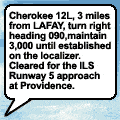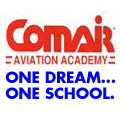Departments

Inside AOPA 
On Capitol Hill 
Airport Support Network

Quiz Me! 
The Road to Expo 
ePilot Calendar 
Weekend Weather
| GA News
| AVIATION GETS A NEW SPARK
Dr. Forrest M. Bird recently took off in his Piper J–3 Cub without spark plugs or magnetos, according to information released to ePilot Tuesday. Instead, the engine was running on SmartPlugs, a new catalytic ignition system that doesn't have moving parts and doesn't require a high-voltage source. During testing in Sandpoint, Idaho, Bird said the engine ran flawlessly between 2,300 and 2,700 rpm. The biggest advantage of the system is safety, while it also enables engines to burn low-octane fuels without detonation, weighs only three pounds, and can operate at high altitudes, said Mark Cherry, inventor of the SmartPlug. The technology was developed and tested over the last 10 years by Automotive Resources Inc. The system is internationally patented and has been licensed to kNew Corporation, a newly formed manufacturing and marketing company in Sandpoint. SmartPlug has received funding from NASA, the Environmental Protection Agency, and the Department of Defense. The company intends to, in turn, license the technology to a manufacturer that would then take it through the FAA certification process. For more information, call 208/265-2723 or e-mail [email protected].
CESSNA BITES PITTS
A Cessna 172 and a Pitts Special S1-S had a wild ride near Disneyland Sunday evening. Michael F. Hartman, 40, of Montclair, California, was flying his 172 in formation behind the Pitts, flown by Martin W. Kusch, 33, of Rancho Cucamonga, when the two collided a few miles southwest of Disneyland. The Cessna's propeller was damaged after it sliced through the Pitts' vertical stabilizer at 6:50 p.m., according to an FAA preliminary report. After declaring an emergency, they flew their crippled airplanes to Fullerton Airport. They circled above the airport to give rescue vehicles time to get in position on the runway, The Los Angeles Times reported. There were no injuries. Kusch was contacted by ePilot Tuesday, but declined to comment.
GERMAN DESIGNERS DEVELOP GIANT GLIDER
 A group of famous, race-winning glider pilots has commissioned German designers to develop a giant ship, capable of a new level of cross-country performance. Called the eta after the seventh letter in the Greek alphabet, the two-seat glider has a 31-meter (101-foot) wingspan–making it the largest sailplane in the world–and a retractable engine for self-launching capability. It made its maiden flight on July 31, and no problems were reported within the first 30 hours of flight testing. The performance figures are still being determined, but it's designed for Open Class racing where modern gliders have achieved glide ratios of 60 to 1. Photos of the eta show how the glider, which weighs 2,000 pounds at maximum gross weight, easily dwarfs a comparable 18-meter ship. The design is intended for production. To stay current on the glider's progress, visit the Web site. A group of famous, race-winning glider pilots has commissioned German designers to develop a giant ship, capable of a new level of cross-country performance. Called the eta after the seventh letter in the Greek alphabet, the two-seat glider has a 31-meter (101-foot) wingspan–making it the largest sailplane in the world–and a retractable engine for self-launching capability. It made its maiden flight on July 31, and no problems were reported within the first 30 hours of flight testing. The performance figures are still being determined, but it's designed for Open Class racing where modern gliders have achieved glide ratios of 60 to 1. Photos of the eta show how the glider, which weighs 2,000 pounds at maximum gross weight, easily dwarfs a comparable 18-meter ship. The design is intended for production. To stay current on the glider's progress, visit the Web site.
PILOTS ASKED TO TAKE ACCIDENT SURVEY
Last March, NASA granted $500,000 to a New Zealand university to improve pilot training using aircraft accident and incident case studies. Phase one of the effort is where you come in. Under the two-year project, the University of Otago in Dunedin, New Zealand, will take an international survey of pilots, seeking information on critical aircraft accidents and incidents. You can see the survey on the Web. Researchers will also look into existing public aviation accident records. A new computer-based pilot training program is to be the end result of all the research.
For daily news updates, see AOPA Online.
|
Inside AOPA
| GA DOESN'T CAUSE AIRLINE DELAYS, AOPA TELLS SLATER
Secretary of Transportation Rodney Slater called a second summit meeting recently to discuss airline delays, this time involving representatives from the "low-cost" and regional airlines, consumer organizations, and AOPA, along with other aviation industry representatives. AOPA reiterated that general aviation doesn't contribute to airline delays. Dennis Roberts, AOPA vice president and executive director of government and technical affairs, told Slater and FAA Administrator Jane Garvey privately that they must not disregard the impacts on GA if the FAA changes the air traffic system. "Don't fix a problem in one place and create a new problem elsewhere," Roberts said. AOPA will monitor any proposed changes to ensure that GA access to airspace is preserved.
FAA TO OFFER ONLINE SLOT SERVICE
Pilots needing ATC "slot" reservations for arrival at major sporting and other events will be able to make those reservations on the Web starting September 18, AOPA has learned. AOPA has been pressuring the FAA for more Web-based services. Slots had previously been available only through a cumbersome telephone keypad entry process or by using special computer software and a slow dial-up connection. "Nobody likes having to require slots," said Melissa Bailey, AOPA director of air traffic services. "But at least it's much less awkward for pilots to use on the Web. We congratulate the FAA on taking our advice to use technology intelligently." The first event for the system will be the Formula One Grand Prix Race in Indianapolis, September 22 through 25. The new system will also serve pilots planning IFR flights to AOPA Expo 2000. A user's guide for the new system will be available by September 11 on the Web.
AOPA CALLS FOR A 'REALISTIC' MOVE FORWARD ON WAAS
Following the FAA's announcement last week that the GPS Wide Area Augmentation System (WAAS) signal is now available fulltime, AOPA is urging the agency to move forward with a realistic certification program for the enhanced satellite navigation system. "This announcement means that we've moved one step closer to what AOPA has long been advocating–a satellite-based navigation system that can provide accurate instrument approaches to virtually any airport," said AOPA President Phil Boyer. "Now the FAA must move forward with a WAAS certification program that focuses on what's needed and achievable, and not demand an impossible standard of theoretical perfection." The FAA said last week that WAAS had successfully completed a 21-day stability test, allowing immediate use of the system by a broad range of users. WAAS enhances the GPS signal to provide improved accuracy, availability, and reliability, although it's not yet approved for IFR use.
AOPA'S BOYER MEETS WITH SENATOR ON AVIATION
AOPA President Phil Boyer visited with Senate aviation subcommittee Chairman Slade Gorton (R-Wash.) at his home in Seattle this past weekend. Boyer talked with Gorton about a wide range of aviation issues to better understand the senator's views on ATC privatization, user fees, and the push by the major airlines for FAA reform. Gorton understands the role GA plays in the Pacific Northwest and on the national level. In fact, he used a general aviation aircraft recently to return from Coeur d'Alene, Idaho, to Seattle. Gorton is up for reelection this year and faces a primary next month. There are more than 10,000 AOPA members in Washington state.
| On Capitol Hill
| CONGRESS SET TO RETURN FROM SUMMER RECESS
As Congress prepares to return next Tuesday from its annual summer recess, a host of issues affecting general aviation remain unresolved. The House and Senate adjourned in July without finishing work on the legislation funding the FAA in fiscal year 2001. The legislation was reported out of the House and Senate in June; however, no conference has been held to resolve differences between the versions. Legislative efforts to protect backcountry airstrips are also expected to increase with the return of lawmakers to Capitol Hill. The House is expected to bring a bill to the floor that would stop federal agencies from permanently closing airstrips on public lands without first consulting state aviation departments. The AOPA-supported legislation also provides for a 90-day comment period in which issues of closure can be heard. Meanwhile, the House and Senate will meet in conference committee over the Interior Appropriations Bill that was not completed in July. The Clinton administration has continued to indicate that it will not support an amendment to the bill sponsored by Sen. Mike Crapo (R-Idaho), prohibiting federal funds from being used to close airstrips on land regulated by the Department of the Interior, leaving the legislation's future in doubt. In fact, many Capitol Hill experts now believe Clinton is likely to call the Congress into a "lame-duck session" after the election in an effort to pass legislation he feels is important before he leaves office.
| Airport Support Network
| VOLUNTEER OF THE WEEK–PAUL DEVORE
Airport Support Network volunteer Paul DeVore of Morgantown Municipal Airport in West Virginia recently reported on several ongoing efforts in which he and the Hart Field Coalition have been actively involved. Along with the West Virginia Association for Women in Science, the coalition hosted a one-day Women and Aviation program earlier this year for eighth-grade girls. The goal was to encourage young women to enroll in more math and science courses and to consider careers in aviation. Also on the education front, the coalition and DeVore, who serves as president, have been able to gradually increase West Virginia University's involvement in aviation. WVU has reestablished a pilot ground school course for college credit. And this fall, for the first time in nearly 20 years, the university will offer a flight training course worth three credit hours. Under DeVore's guidance, the coalition is initiating an aviation education and scholarship program that will provide one year of flight training for 16- to 20-year-olds.
ASN VOLUNTEER WINS AOPA AWARD
AOPA Airport Support Network volunteer Christopher Andrews received the AOPA Award of Excellence from AOPA President Phil Boyer on August 29 for his work in forcing Des Moines International Airport officials to recognize the needs of general aviation. The award was presented to Andrews at the AOPA Pilot Town Meeting in Des Moines. Andrews is the first recipient of the award that is now given to ASN volunteers who demonstrate "extraordinary commitment" in efforts to build support for local airports. Andrews discovered last fall that airport officials were more interested in the growth of large cargo operations than in general aviation uses. Among other things, officials had planned permanent closure of Runway 13R/31L, which last year handled some 44,000 operations, mostly general aviation. Andrews reported the issue to AOPA and is continuing to provide research, rally local pilots, arrange local media attention, and work with local politicians.
Click here to learn more about the Airport Support Network.
| Quiz Me!
| Here’s a question asked by an AOPA member last week of our AOPA technical specialists. Test your knowledge.
Question: Where can I find information or a chart that gives the weight and density of 100LL fuel at different temperatures?
Answer: The FAA's Aircraft Weight and Balance Handbook contains a chart that gives the specific weight in pounds per U.S. gallon for aviation fuels based on temperature in degrees Celsius. It covers Jet A, Jet A1, Jet B, and 100/130 octane aviation fuels. This handbook, FAA-H-8083-1, is typically available through your local FBO or through the Government Printing Office.
Got a technical question for AOPA specialists? Call 800/872-2672 or e-mail to [email protected]. Send comments on our Quiz Me! questions to [email protected].
| The Road To Expo
| Medical questions? Get all the answers at AOPA Expo 2000 from October 20 through 22 in Long Beach, California. Meet one-on-one with a medical examiner and an aviation pharmacist from noon to 3 p.m. on Sunday in the convention center. Plus don't miss medical seminars that will deal with such problems as diabetes, hypertension, and high blood pressure. There will be more than 500 exhibits, 80 aircraft, 82 seminar topics, and product demonstrations galore, as well as exciting social events. For more information, visit the Web site or call 888/GO2-EXPO.
| ePilot Calendar
| WEEKEND FLYING DESTINATIONS
Ocean City, Maryland. The Annual Air Affair at Ocean City Municipal Airport (OXB) takes place September 2. Featuring vintage aircraft. Call 410/213-2471 for event information.
Cleveland, Ohio. The Cleveland National Air Show takes place September 2 through 4 at Burke Lakefront Airport (BKL), 216/781-6411. Featuring the USAF Thunderbirds and U.S. Army Golden Knights. Call 216/781-0747 for event information.
Galesburg, Illinois. The National Stearman Fly-In takes place September 4 through 10. The largest gathering of Stearman airplanes takes place at Galesburg Municipal Airport (GBG), 309/342-3134. Call 309/343-6409 for event information.
Colorado Springs, Colorado. The Colorado Springs Balloon Classic takes place September 2 through 4. Featuring 110 hot air balloons and a huge kite display. The City of Colorado Springs Municipal Airport (COS), 719/550-1900, serves the area. Call 719/471-4833 for event information.
Storm Lake, Iowa. The Great Iowa Balloon Race takes place September 1 through 4. Skill races fly every dawn and dusk. Storm Lake Municipal Airport (SLB), 712/732-6494, serves the area. Call 712/732-7303 for event information.
For more airport details, see AOPA’s Airport Directory Online. For more events, see the Aviation Calendar of Events.
ASF FLIGHT INSTRUCTOR REFRESHER CLINICS
(All clinics start at 7:30 a.m.)
The next AOPA Air Safety Foundation Flight Instructor Refresher Clinics are scheduled in Van Nuys, California, Boston, Massachusetts, and Des Moines, Iowa, September 9 and 10. For complete details, visit the Flight Instructor Refresher Clinic schedule.
ASF SAFETY SEMINARS
The next AOPA ASF Safety Seminars are scheduled in Pittsburgh (West Mifflin), Pennsylvania, September 11; Harrisburg (New Cumberland), Pennsylvania, September 12; and Middletown, New Jersey, September 14. The seminar topic is GPS for VFR Operations. Familiarity with GPS is essential because it is the navigation system of the future. You will learn rules for survival in an electronic environment as well as advantages and disadvantages of using GPS; GPS capabilities; how to navigate using GPS; and traps and tricks of GPS navigation. Pilots of all skill levels and experience will benefit from this thorough review of GPS in VFR conditions. For more information about ASF Safety Seminars, visit the Web site.
ASF PINCH HITTER GROUND-SCHOOL COURSES
(Pinch Hitter courses start at 9:30 a.m.)
The next Pinch-Hitter� Ground School will take place September 24 in Colorado Springs, Colorado. For details and a complete schedule, see the Pinch Hitter Ground School Schedule.
AOPA PILOT TOWN MEETINGS
Featuring AOPA President Phil Boyer
(7:30 p.m.; admission is free)
The next Pilot Town Meetings are in Lansing, Michigan, September 11; Houston, Texas, September 18; and Atlanta, Georgia, September 19. Click for more information on Pilot Town Meetings.
|
Contacting ePilot
Got news? Having difficulty using this service? Visit the ePilot Frequently Asked Questions now at AOPA Online or write to [email protected]. To UNSUBSCRIBE: reply to this e-mail, a free weekly newsletter on general aviation, with the word "unsubscribe" as the subject. Do not include a message. To SUBSCRIBE: visit ( http://www.aopa.org/members/epilot.html).
AOPA, 421 Aviation Way, Frederick, MD 21701
Telephone: 800/USA-AOPA or 301/695-2000
Copyright � 2000. Aircraft Owners and Pilots Association.
| Sponsors
        
|


 A group of famous, race-winning glider pilots has commissioned German designers to develop a giant ship, capable of a new level of cross-country performance. Called the eta after the seventh letter in the Greek alphabet, the two-seat glider has a 31-meter (101-foot) wingspan–making it the largest sailplane in the world–and a retractable engine for self-launching capability. It made its maiden flight on July 31, and no problems were reported within the first 30 hours of flight testing. The performance figures are still being determined, but it's designed for Open Class racing where modern gliders have achieved glide ratios of 60 to 1. Photos of the eta show how the glider, which weighs 2,000 pounds at maximum gross weight, easily dwarfs a comparable 18-meter ship. The design is intended for production. To stay current on the glider's progress, visit the
A group of famous, race-winning glider pilots has commissioned German designers to develop a giant ship, capable of a new level of cross-country performance. Called the eta after the seventh letter in the Greek alphabet, the two-seat glider has a 31-meter (101-foot) wingspan–making it the largest sailplane in the world–and a retractable engine for self-launching capability. It made its maiden flight on July 31, and no problems were reported within the first 30 hours of flight testing. The performance figures are still being determined, but it's designed for Open Class racing where modern gliders have achieved glide ratios of 60 to 1. Photos of the eta show how the glider, which weighs 2,000 pounds at maximum gross weight, easily dwarfs a comparable 18-meter ship. The design is intended for production. To stay current on the glider's progress, visit the 










